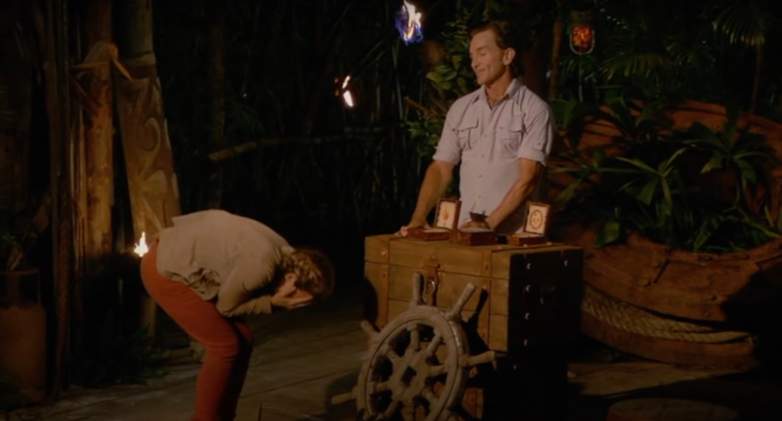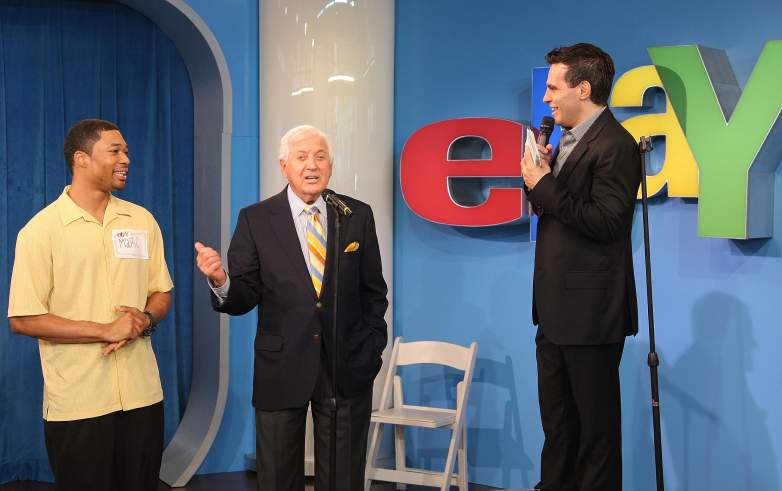
Getty/CBS "Let's Make a Deal" host Monty Hall in 2003/"Survivor" host Jeff Probst on "Survivor 41."
“Survivor 41” saw the introduction of a controversial new twist called “Do or Die,” in which the final 7 contestants had to choose between competing in the immunity challenge and facing a “potentially deadly game of chance,” or sitting out of the challenge, thereby avoiding the twist while also remaining vulnerable. It returned on Wednesday night’s episode of “Survivor 42.”
So what does it have to do with Monty Hall, and what’s up with the odds here? Here’s what you need to know:
What is ‘Survivor Do or Die’?

YouTubeHost Jeff Probst reveals that Lindsay Dolashewich picked the correct box in the “Do or Die” twist in episode 11 of “Survivor 42.”
The “potentially deadly” game, “Do or Die,” would be played by whoever fell out of the challenge first (though the challenge was different both times, they were both endurance challenges). Do or Die turned out to be a Monty Hall-style problem in which host Jeff Probst would offer the contestant a choice of three boxes at that night’s Tribal: one which contained a flame, which represented life, and two which contained a skull, which represented death.
If the contestant chose the flame, they would be safe from that night’s Tribal Council and would live to see the final 6. If they chose the skull, however, they would “die,” i.e. immediately leave Tribal Council and head to the jury without any chance of salvation.
Once the contestant made their pick, Probst would remove one of the other boxes that wasn’t chosen, and gave the contestant the chance to switch. In “41,” 20-year-old contestant Xander Hastings immediately recognized the situation as the Monty Hall problem; similarly, though he did not name it, jury member Hai Giang silently encouraged Lindsay Dolashewich to switch in “42,” signaling his familiarity with the problem.
Both times, the contestant – Deshawn Radden in “41” and Lindsay Dolashewich in “42” – chose not to switch, unknowingly (at least in Deshawn’s case) going against the odds. However, it ended up working out for both of them.
Here’s why, theoretically at least, the odds were not in their favor:
What is the Monty Hall Problem & Why You Should Switch:

GettyMonty Hall (center) hosts eBay’s “Let’s Make A Daily Deal” game show in 2009.
The Monty Hall problem is named after “Let’s Make a Deal” host Monty Hall, who, starting in the 1970s, would often give the contestants of his show a choice to pick one of three doors, behind one of which was a car, and behind the other two would be duds, oftentimes a goat. Like Probst, Hall would then open one of the doors not picked by the contestant, revealing it to be a dud, and give them the chance to switch.
Contrary to intuition, after being given the chance to switch, contestants do not have a 50% chance of picking the right door (or box) either way; in fact, they have a 2/3 chance of picking the right option if they switch. This is essentially because, as BetterExplained explains, you only had a 1/3 chance of picking correctly in the first place. That means your odds remain the same when the host knowingly eliminates one of the duds, meaning the chances that the other door – or box – is not a dud increases to 2/3.
Think of it this way: if you picked one out of 100 doors with a car behind only one of them, the chances are incredibly low that you picked the right one. Once the host eliminates 98 of the other doors, knowing that the prize is behind either the one he didn’t eliminate or the one you chose, chances are high it’s the one he didn’t eliminate. So, you should switch. It’s the same with three options to start, just with smaller numbers.
BetterExplained even gives you the chance to play the game yourself, in order to test it out.
The Odds Were Stacked Against Lindsay & Deshawn

YouTube“Survivor 42” jury members react to Lindsay picking the correct box in episode 11.
With all that being said, both Lindsay and Deshawn chose not to switch, and it paid off for them. There’s about an 11% chance of that happening twice in a row.
It is currently unknown as to whether Lindsay knew of the Monty Hall problem when deciding to stick with her gut, but Deshawn, the first ever contestant subjected to Do or Die, has stated in post-game interviews that he was unfamiliar with the problem, and likely would have switched had he known. Luckily, his ignorance worked out for him.
It is also unknown as to whether Probst and the “Survivor” production team will decide to bring back the “Do or Die” twist, given that many of the twists introduced in “Survivor 41” and reused in “42” were impactful only because of their novelty, both to the viewers and contestants. Chances are we will see a shakeup of twists for ongoing seasons, but that as of now, Do or Die may have seen its last day.
“Survivor 42” airs Wednesdays at 8 p.m. Eastern on CBS. Two more episodes of the season remain. The three-hour finale airs Wednesday, May 25, 2022.